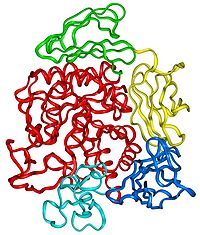
Cyclodextrin glycosyltransferase
Encyclopedia

Enzyme
Enzymes are proteins that catalyze chemical reactions. In enzymatic reactions, the molecules at the beginning of the process, called substrates, are converted into different molecules, called products. Almost all chemical reactions in a biological cell need enzymes in order to occur at rates...
belonging to the same family of the α-amylase
Amylase
Amylase is an enzyme that catalyses the breakdown of starch into sugars. Amylase is present in human saliva, where it begins the chemical process of digestion. Food that contains much starch but little sugar, such as rice and potato, taste slightly sweet as they are chewed because amylase turns...
specifically known as glycosyl-hydrolase family 13. This peculiar enzyme is capable of catalyzing more than one reaction with the most important being the synthesis of non-reducing cyclic dextrin
Dextrin
Dextrins are a group of low-molecular-weight carbohydrates produced by the hydrolysis of starch or glycogen. Dextrins are mixtures of polymers of D-glucose units linked by α- or α- glycosidic bonds....
s known as cyclodextrin
Cyclodextrin
Cyclodextrins are a family of compounds made up of sugar molecules bound together in a ring ....
s starting from starch
Starch
Starch or amylum is a carbohydrate consisting of a large number of glucose units joined together by glycosidic bonds. This polysaccharide is produced by all green plants as an energy store...
, amylose
Amylose
Amylose is a linear polymer made up of D-glucose units.This polysaccharide is one of the two components of starch, making up approximately 2-30% of the structure...
, and other polysaccharide
Polysaccharide
Polysaccharides are long carbohydrate molecules, of repeated monomer units joined together by glycosidic bonds. They range in structure from linear to highly branched. Polysaccharides are often quite heterogeneous, containing slight modifications of the repeating unit. Depending on the structure,...
s.
CGTase is an enzyme common to many bacterial species, in particular of the Bacillus genus
Genus
In biology, a genus is a low-level taxonomic rank used in the biological classification of living and fossil organisms, which is an example of definition by genus and differentia...
(e.g. B. circulans, B. macerans and B. stearothermophilus), as well as to some archaea
Archaea
The Archaea are a group of single-celled microorganisms. A single individual or species from this domain is called an archaeon...
, but it is not known to be present in any other species.
Catalytic activities
All of the CGTases can catalyze up to four reactions: cyclization, coupling, disproportionation and hydrolysis. All these activities share the same catalytic mechanism which is common to all glycosyl-hydrolases.Cyclization is the process through which a linear polysaccharidic chain is cleaved and the two ends of the cleaved fragment are joined to produce a circular dextrin (cyclodextrin or CD): on the basis of the number of sugar residues this circular product is made of three main type of cyclodextrins can be distinguished, α-CD with six residues, β-CD with seven residues and γ-CD with eight residues.
The coupling reaction can be easily described as the reverse process of cyclization: the enzyme cleaves a cyclodextrin to produce a linear dextrin which is subsequently joined to a linear oligosaccharide.
Disproportionation is very similar to coupling, but the cleaved dextrin is not a cyclodextrin, but a linear oligosaccharide that is then joined to a second oligosaccharide.
CGTase also has a weak hydrolyzing activity which consists in cleaving the longer polysaccharidic chains into shorter fragments.

